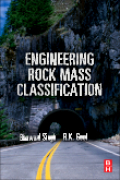
Engineering rock mass classification: tunnelling, foundations and landslides
Goel, R.K.
Singh, Bhawani
Rock mass classification methods are commonly used at the preliminary design stages of a construction project when there is very little information. It forms the bases for design and estimation of the required amount and type of rocksupport and groundwater control measures. Encompassing nearly all aspects of rock mass classifications in detail, Civil Engineering Rock Mass Classification: Tunnelling, Foundations and Landsides provides construction engineers and managers with extensive practical knowledge which is time-tested in the projects in Himalaya and other parts of the world in complex geological conditions. Rock mass classification is an essential element of feasibility studies for anynear surface construction project prior to any excavation or disturbances made to earth. Written by an author team with over 50 years of experience in someof the most difficult mining regions of the world, Civil Engineering Rock Mass Classification: Tunnelling, Foundations and Landsides provides construction engineers, construction managers and mining engineers with the tools and methods to gather geotechnical data, either from rock cuts, drifts or core, and process the information for subsequent analysis. The goal is to use effective mapping techniques to obtain data can be used as input for any of the establishedrock classification systems. The book covers all of the commonly used classification methods including: Barton's Q and Q' systems, Bieniawski's RMR, Laubscher's MRMR and Hoek's and GSI systems. With this book in hand, engineers will be able to gather geotechnical data, either from rock cuts, drifts or core, and process the information for subsequent analysis. Rich with international case studies and worked out equations, the focus of the book is on the practical gathering information for purposes of analysis and design. Identify the most significant parameters influencing the behaviour of a rock mass. Divide a particular rock mass formulation into groups of similar behaviour, rock mass classes of varying quality. Provide a basis of understanding the characteristics of each rock mass class Relate the experience of rock conditions at one site to the conditions and experience encountered at others Derive quantitative data and guidelines for engineering design Provide common basis for communication between engineers and geologists
- ISBN: 978-0-12-385878-8
- Editorial: Butterworth-Heinemann
- Encuadernacion: Cartoné
- Fecha Publicación: 26/08/2011
- Nº Volúmenes: 1
- Idioma: Inglés
